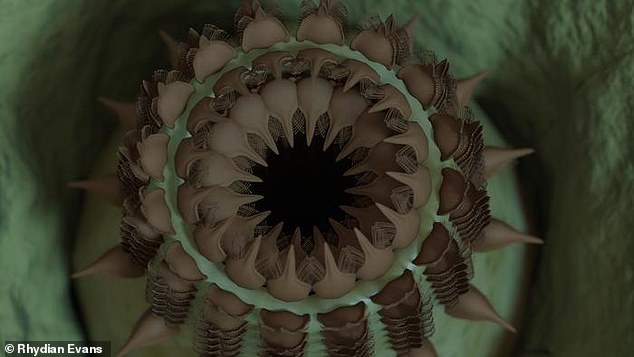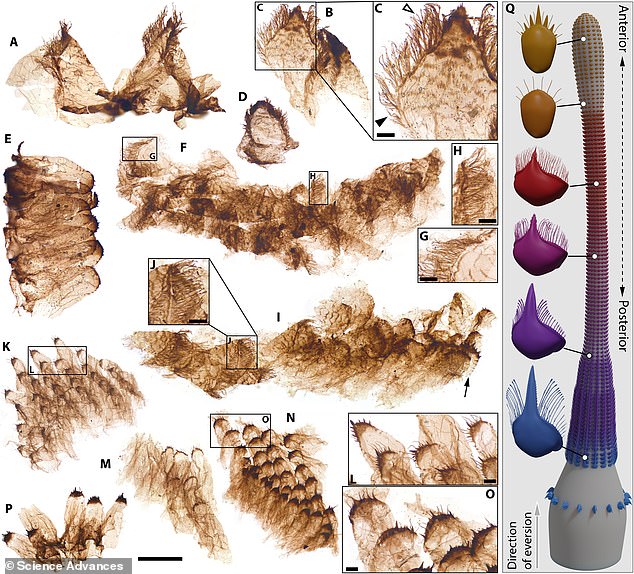Scientists have uncovered a strange, ancient creature in the Grand Canyon that could rewrite the origin of life.
Researchers from Cambridge found hundreds of tiny remains of a ‘penis worm’ buried deep in 500-million-year-old rocks in canyon walls in Arizona, revealing that the region once held perfect conditions for life to rapidly evolve.
The fossilized creature featured hairy teeth that turned its mouth inside out to catch food.
This study challenged the long-held belief that early complex life only evolved in harsh, oxygen-starved places, as the newly found soft-bodied fossils were found in a calm, oxygen-rich sea, a setting where remains usually rot too fast to fossilize.
Researchers said that the Grand Canyon site acted like a ‘Goldilocks zone,’ not too extreme, not too barren, offering just the right conditions for early life to grow, evolve, and leave a mark.
Giovanni Mussini, a PhD student in Earth Sciences, University of Cambridge, UK, and the lead author of the study, said: ‘This was the best real estate on Earth at the time.’
‘You had enough food, enough light, and the perfect depth. That’s where evolution really kicked into gear.’
The findings support the theory of evolutionary escalation, the idea that species evolve not only in response to their environment, but also to gain an edge over competing species.

Researchers have uncovered fossils buried deep in 500 million old rocks in canyon walls

The scientist found a strange penis worm that turned its mouth inside out to catch the food. Pictured is a reconstruction of what the ancient creature once looked like
The soft-bodied animal fossils were uncovered in a layer of mudstone called the Bright Angel Formation, where most of the canyon’s Cambrian-era fossils have been found.
Researchers suggested that the fossils date back to a time when most major animal groups were just beginning to appear on Earth.
Back then, the Grand Canyon region sat near the equator and was covered by a shallow sea, roughly 130 to 165 feet deep, with high oxygen levels, and the water was rich in nutrients.
Scientists believe photosynthetic microbes helped pump even more oxygen into the water, creating the perfect conditions for larger, more complex life to thrive.
The team uncovered over 1,500 microscopic strange fossils, including prawns with filter-feeding limbs, mollusks with chains of teeth, and weird worms with long, branching mouthparts.
Moreover, the study published in Science Advances focused on a specific group of fossils called small carbonaceous fossils, or SCFs. These are microscopic remains of animals that did not have shells or bones, so they almost never show up in the fossil record.
But in this case, researchers said the muddy seafloor buried them and kept them safe, and this rare preservation led them to see incredible details including tiny molars in shrimp-like creatures and delicate tooth rows in mollusks.
‘This is a completely new way to look at life from the Cambrian period,’ Mussini said.
‘We are seeing parts of animals that are almost never preserved,’ he added.

These fossils were found at a site that was once underwater hundreds of millions of years ago
Researchers found a strange creature called Kraytdraco spectatus, or a penis worm.
They also discovered 967 fossils out of the 1,539 fossils of this one type of worm. It had a flexible tube-like mouth lined with hundreds of teeth shaped like tiny brushes.
They compared it to simple living worms, and found out that Kraytdraco was about one and half to four inches long. That made it one of the larger animals in its neighborhood, and probably one of the more dominant.
They also found out, unlike predators that eat other animals, this worm was likely to scrape up debris and filter its food from soil. Its body was built for gathering and sorting food, a sign it had plenty of energy to grow elaborate tools.
They said that these species have complex organs and features, which scientists believed evolved slowly and only in tough environments, but the new fossils rewrote the idea.
Susannah Porter, a paleontologist at UC Santa Barbara, said: ‘It’s not unlike if we only had great fossil records from Antarctica… but then suddenly we find human fossils in New York City, where people actually flourished.’
‘We now get to see different kinds of evolutionary pressures, not just it’s freezing, it’s really hot, there’s not a lot of water,’ Porter explained.
Scientists are still trying to figure out what sparked the Cambrian explosion, when most major animal groups first appeared.
The most widely accepted idea is that oxygen levels in Earth’s atmosphere began to rise about 550 million years ago, said Erik Sperling, an associate professor at Stanford University.
Sperling suggested that with more oxygen, animals could turn food into energy more efficiently, giving them the boost they needed to move, grow, and hunt.
‘The (emergence of) predators kicked off these escalatory arms races, and then we basically got the explosion of different ways of doing business,’ Sperling said.
The Grand Canyon stretches 277 miles and plunges more than a mile deep. If even a small part of it contains this level of fossil preservation, scientists say it could become one of the most important sites for tracing the origins of complex life on Earth.












